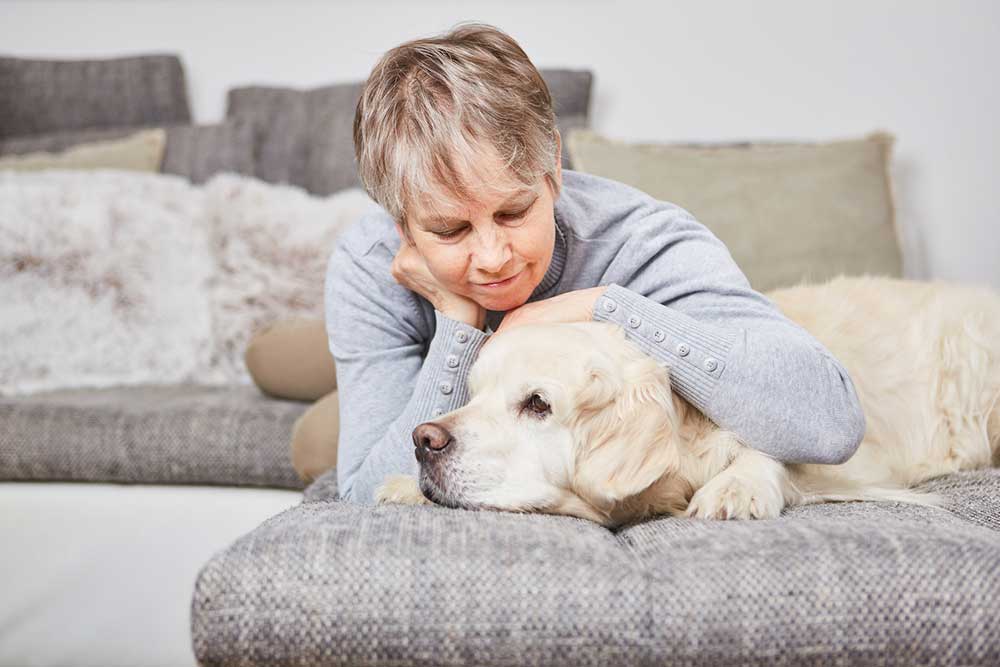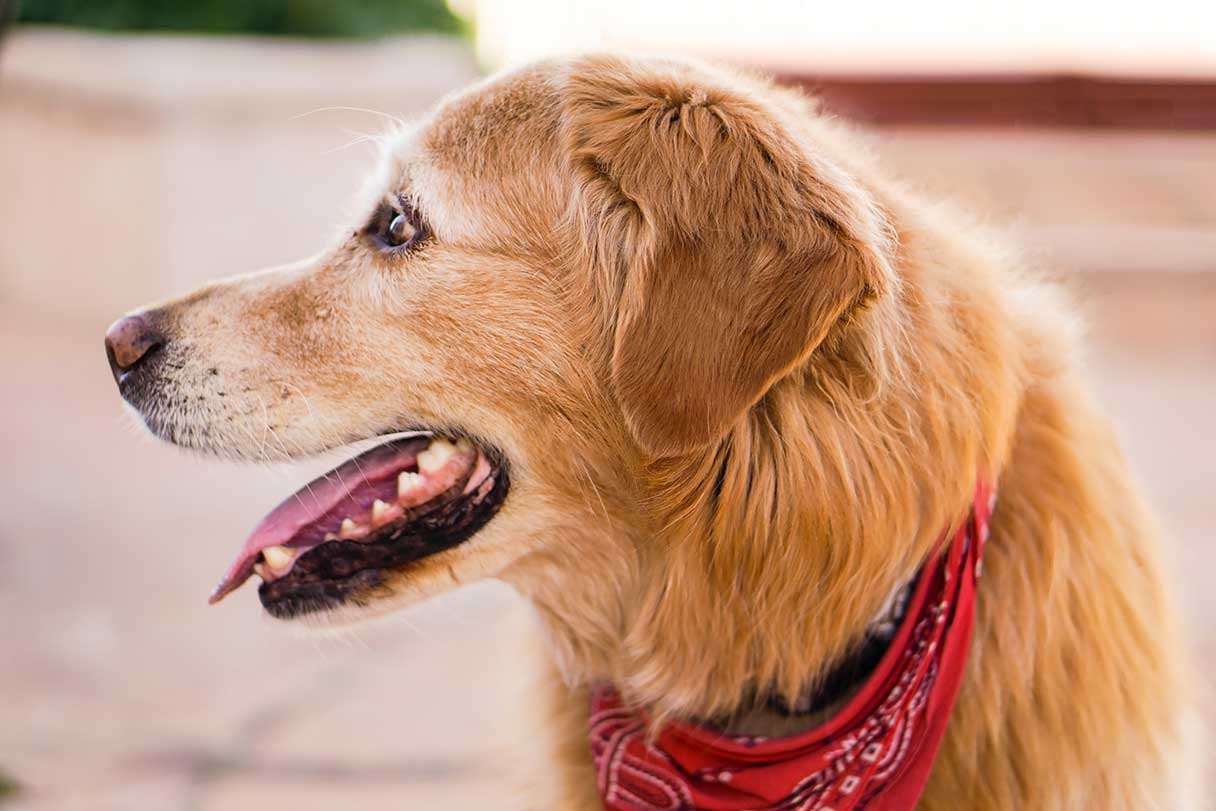Those big puppy dog eyes that gaze at you in adoration are one of the best things about our beloved pups. Naturally, you want to protect your dog’s eye health so they’ll be able to go on gazing at you for as long as possible. Learn about these 12 common eye problems that affect dogs so you can keep a vigilant watch over your furry bestie’s eye health.
1. Cataracts
Cataracts in dogs occur when the lens of the eye becomes cloudy and opaque, preventing light from getting to the retina. This can cause impaired vision and, in severe cases, blindness. Cataracts can happen to any dog at any age, although some dogs have a genetic predisposition toward getting them. They can also be caused by eye injuries, diabetes and old age.1
Dog breeds most vulnerable to cataracts
The following dog breeds are often susceptible to developing cataracts:1
- Boston terrier
- Cocker spaniel
- Labrador retriever
- Poodle
- Welsh springer spaniel
Treatments for dog cataracts
In most cases, cataracts can be surgically removed by a veterinary ophthalmologist. For dogs who aren’t good candidates for surgery, vets may prescribe medicated eye drops — either corticosteroid or nonsteroidal anti-inflammatory drugs (NSAIDs) — to reduce eye inflammation and prevent glaucoma from developing. However, medicated eye drops won’t do anything to reduce the actual cataract.1
2. Cherry Eye
Cherry eye is what it’s generally called when a dog’s inner third eyelid pops out, forming a red or pink bulge in the corner of the eye. This third eyelid, also known as the nictitating membrane, houses a dog’s tear ducts. Dogs with cherry eye don’t receive proper protection and lubrication from this membrane, leaving them in danger of chronic dry eye, which could be damaging long term.2
Dog breeds prone to cherry eye
These dog breeds may have a higher incidence of cherry eye:2
- Beagle
- Bloodhound
- Boston terrier
- Cocker spaniel
- French bulldog
- Lhasa apso
- Pug
- Shih tzu
- Other brachycephalic (short-nosed) breeds
Treatments for cherry eye in dogs
Cherry eye needs to be corrected with surgery. Until the surgery can take place, your vet will most likely prescribe an eye ointment to keep the eye properly lubricated.2
3. Cloudiness
Nuclear sclerosis and lenticular sclerosis are interchangeable medical terms for the bluish haziness that sometimes appears in a dog’s eyes in old age. Despite the serious-sounding names, this is normal discoloration in the eyes of senior dogs, and it has no impact on their vision.3
Treatments for cloudiness in dog eyes
There is no treatment for this condition because none is needed. That said, it can be difficult for the untrained eye to tell the difference between normal eye cloudiness and cataracts (above), so it’s a good idea to have your vet check your fur pal’s eyes to be sure.3
Also, dogs who develop cloudiness tend to be more prone to cataracts. Regular senior dog checkups will help your vet keep an eye on your dog’s vision so they can know if any real problems crop up.3
4. Corneal Ulcers
The cornea is the outer membrane of the eyeball, made up of three layers: the surface layer (epithelium), the stroma and the Descemet’s membrane. A corneal ulcer occurs when cells of the cornea erode through the epithelium and into the stroma layer, causing fluid to accumulate in the stroma layer. Trauma or injury to the eye is the most common cause, but a corneal ulcer can also be caused by eye infections and diseases like diabetes, Cushing’s disease or hypothyroidism.4
Dog breeds vulnerable to corneal ulcers
These dog breeds may be prone to corneal ulcers:5
- Boston terrier
- Pug
- Other large-eyed, brachycephalic breeds
Treatments for corneal ulcers in dogs
A surface abrasion on the cornea can be treated with antibiotic eye drops or ointment and monitoring. An actual corneal ulcer, however, will likely need surgery to repair, which is done by removing the damaged cells to allow healing. After surgery, your dog may be fitted with a temporary contact lens to protect the eye while it heals.5
5. Conjunctivitis (Pink Eye)
Conjunctivitis, commonly known as pink eye, is inflammation of the conjunctiva tissue surrounding the eye. That’s the thin mucous membrane that coats the white of the eye and the lining of the eyelids.6
When a dog has conjunctivitis, this membrane turns red and swells up, causing additional symptoms that include eye discharge, squinting and excessive blinking. It’s usually caused by a viral or bacterial infection, although some autoimmune disorders can also cause conjunctivitis, as can some breed-specific health conditions. Eyelid disorders like entropion (when the eyelids turn in) or ectropion (when the eyelids turn out) can also cause pink eye.6
Dog breeds prone to conjunctivitis
The following dog breeds may have a higher incidence of conjunctivitis:6
- Collies
- Collie mixes
Treatments for dog conjunctivitis
Treatment is targeted at the underlying cause. If it’s caused by an infection, both topical and oral medications may be prescribed, including antibiotics and anti-inflammatory medications. If it’s caused by another underlying health condition, then the vet will focus on treating that condition.6
6. Dry Eye
The medical term for dry eye in dogs is keratoconjunctivitis sicca (KCS), which refers to inflammation of the cornea due to lack of sufficient moisture. It’s usually the result of a failure of the tear glands to produce enough fluid to keep the eye lubricated.7
Symptoms of dry eye are similar to those of pink eye, but dry eye usually occurs in middle-aged to senior dogs. The most common cause is autoimmune diseases that attack the tear glands, but it can also be caused by distemper, hypothyroidism, nerve damage and certain antibiotic medications.7
Dog breeds prone to dry eye
Dog breeds that can be prone to dry eye include:7
- Bloodhound
- Boston terrier
- Cavalier King Charles spaniel
- English springer spaniel
- Lhasa apso
- Miniature schnauzer
- Pekingese
- Pug
- Samoyed
- Shih tzu
- West Highland white terrier
- Yorkshire terrier
Treatments for dry eye in dogs
Treatment focuses on two main objectives: stimulating tear production and replacing tear film. This involves a combination of prescription topical medications that must be applied throughout the day. Some dogs may also be given antibiotics and anti-inflammatory medications to treat any secondary infections or inflammation.7
7. Ectropion
Ectropion is a condition where the eyelid turns inside out. This usually occurs with the lower lids, which gives affected dogs a droopy-eyed appearance. This condition causes the conjunctival lining of the eyelids and the eyeballs, as well as the corneas, to dry out, resulting in conjunctivitis. It can also potentially cause damage to the cornea and vision.8
Ectropion can be a hereditary congenital condition, but it can also be acquired later in life as the result of various conditions, including facial nerve paralysis, hypothyroidism, scarring from injury and chronic eye infections.8
Dog breeds vulnerable to ectropion
These dog breeds may have a higher incidence of ectropion:8
- Basset hound
- Bernese mountain dog
- Bloodhound
- Bulldog
- Chow chow
- Clumber spaniel
- Cocker spaniel
- English springer spaniel
- Mastiff
- Newfoundland
- Saint Bernard
Treatments for dog eyelid ectropion
Mild ectropion is usually treated with eye drops and ointments to keep the eyes lubricated. More severe cases may need to be surgically corrected.8
8. Entropion
Entropion is the opposite of ectropion. It happens when the eyelid turns inward, causing the hair on the outer lid to rub against the cornea. This can in turn cause eye pain and corneal ulcers, among other complications. It’s usually a hereditary condition and is most often seen in puppies and young dogs who are still growing. However, it can occur in any dog as the result of an injury or inflammation.9
Dog breeds prone to entropion
The following dog breeds may be susceptible to entropion:9
- Bloodhound
- Bullmastiff
- Chesapeake Bay retriever
- Chinese shar-pei
- Chow chow
- Clumber spaniel
- Doberman pinscher
- Golden retriever
- Gordon setter
- Great Dane
- Irish setter
- Labrador retriever
- Neapolitan mastiff
- Poodle
- Rottweiler
Treatments for dog eyelid entropion
Entropion must be surgically corrected, which involves removing skin from the eyelid to stop it from rolling inward. In many cases, follow-up surgery is needed after the primary procedure to prevent overcorrection of the eyelid from turning into ectropion. In puppies too young for surgery, the vet may use temporary stitches to hold the eyelid in its correct position until surgery can be done.9
9. Eyelid Lump
Eyelid masses frequently appear on dogs, but the vast majority of them are nonmalignant. There are three main types of dog eyelid lumps:10
- Meibomian gland adenoma and adenocarcinoma. These develop on the meibomian glands inside the upper and lower eyelids. They usually stick out from the edge of the eyelid and may be pink or contain slight-to-dark pigmentation, and large lumps of this type may bleed.
- Melanoma. This is a lump that develops out of the melanin contained in the skin of the eyelid, either on the surface of the eyelid or the pigmented rim.
- Papilloma. This is usually a whitish or pinkish lump that’s caused by a virus, though it may contain pigment. They’re most common in young dogs, but they can affect older dogs as well. In young, healthy dogs, they may go away on their own.
Dog breeds vulnerable to eyelid lumps
The following breeds may be prone to eyelid lumps:11
- Bloodhound
- Bulldog
- Cocker spaniel
Treatments for eyelid lumps on dogs
Because eyelid masses can be uncomfortable for your dog and can cause structural or corneal damage, it’s usually recommended that they be surgically removed and, in the case of potentially cancerous masses, sent for a biopsy.10
10. Glaucoma
Glaucoma is a buildup of intraocular pressure within the eyeball that occurs when fluid within the eye, called aqueous humor, is insufficiently drained. Glaucoma can be primary due to heritable eye abnormalities, or secondary, caused by eye infections or injuries. Secondary glaucoma is most common in dogs.12
Glaucoma is a serious condition that can cause dogs a lot of pain and can result in blindness. Signs include rubbing the eyes, refusing to let you touch them near the eyes, water discharge and swelling and bulging of the eyeballs, as well as lethargy, appetite loss and unresponsiveness.12
Dog breeds vulnerable to glaucoma
The following dog breeds may be more susceptible to glaucoma:12
- Akita
- Alaskan malamute
- Basset hound
- Beagle
- Boston terrier
- Bouvier des Flandres
- Bullmastiff
- Chinese shar-pei
- Chow chow
- Cocker spaniel
- Dalmatian
- English springer spaniel
- Flat-coated retriever
- Giant schnauzer
- Great Dane
- Greyhound
- Italian greyhound
- Miniature pinscher
- Miniature schnauzer
- Norwegian elkhound
- Poodle
- Samoyed
- Shih tzu
- Siberian husky
- Smooth fox terrier
- Welsh springer spaniel
- Wire fox terrier
Treatments for glaucoma in dogs
Medications are usually prescribed that can reduce the eyeball’s fluid production and increase drainage to relieve the pressure. Pain medications may also be given to provide relief. Dogs with manageable glaucoma usually need to take medication long-term. Severe cases may need to be treated surgically to reduce pressure, and dogs who go blind or who don’t respond well to medication may need to have one or both eyes removed.12
11. Retinal Dysplasia
Retinal dysplasia is an early-onset form of progressive retinal atrophy, or PRA, that mainly affects 2- or 3-month-old puppies. PRA — which usually occurs in adult dogs between the ages of 3 to 9 years old — is a degenerative disease that causes the eye’s photoreceptor cells to degrade over time. This initially tends to affect night vision, but as it progresses it can result in complete blindness.13
Dog breeds prone to retinal dysplasia
The following dog breeds may be more vulnerable to retinal dysplasia:13
- Bedlington terrier
- Cavalier King Charles spaniel
- English springer spaniel
- Golden retriever
- Labrador retriever
- Rottweiler
Treatments of retinal dysplasia and PRA in dogs and puppies
Currently, there is no known treatment for either form of PRA. But it’s important to have your veterinarian examine your dog or puppy to rule out other possible causes of vision loss, which may be treatable.13
12. Uveitis
Uveitis is an inflammation of the middle part of the eye known as the uvea. This is made up of the iris, the ciliary body and the choroid. There are different types of uveitis depending on which part of the uvea is inflamed. It can occur in one or both eyes.14
Uveitis is a painful condition that, without proper treatment, can result in permanent eye damage or vision loss.15 Signs include severe pain, red eyes, squinting, eye watering and avoiding bright lights.14 Uveitis is typically caused by infection or injury, but it can also be caused by allergies and underlying autoimmune disorders.15
Dog breeds vulnerable to uveitis
The following breeds may be susceptible to uveitis:15
- Beagle
- Bullmastiff
- Cocker spaniel
- German shepherd
- Labrador retriever
Treatments for uveitis in dogs
The primary treatment involves topical anti-inflammatory medications to reduce inflammation and relieve pain. If the condition is due to an underlying health condition, that will also be treated accordingly.14
Your dog’s eye health is important. But it’s also important to remember that, if the worst-case scenario happens and your dog loses their sight, they can adjust quickly and go on to lead a happy life. Even so, knowing the potential for eye health problems and their signs will help you act quickly to give your pup the best chance of recovery.
CareCredit Credit Card Financing for Dogs
The CareCredit credit card provides a convenient way to pay for your dog's vaccinations and other health and wellness expenses, including exams, medications and products at providers in the CareCredit network.* Continue your wellness journey by downloading the CareCredit Mobile App. You can find a provider on the go, manage your CareCredit account and easily access the Well U blog for more great articles, podcasts and videos. Use our Acceptance Locator to find a veterinarian that accepts CareCredit to help keep your pet healthy and happy for a lifetime of love.
In addition to pet care, you can also use your CareCredit credit card for dentistry, cosmetic, vision, hearing, health systems, dermatology, pharmacy purchases, spa treatments and so much more within the CareCredit network. How will you invest in your health and wellness next?
Author Bio
Jean Marie Bauhaus is a freelance writer and novelist who has been writing pet content since 2013. Her work has appeared on Forbes.com, Hill's Pet, Chewy, AKC.org and more.








